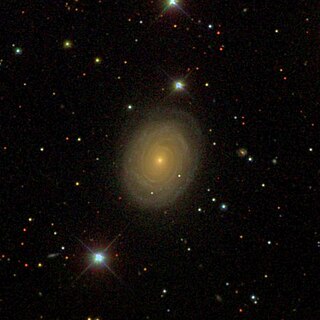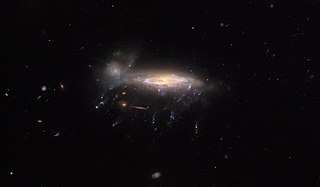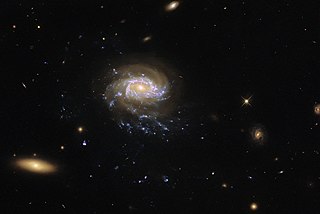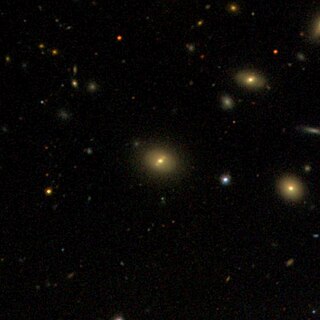
The study of galaxy formation and evolution is concerned with the processes that formed a heterogeneous universe from a homogeneous beginning, the formation of the first galaxies, the way galaxies change over time, and the processes that have generated the variety of structures observed in nearby galaxies. Galaxy formation is hypothesized to occur from structure formation theories, as a result of tiny quantum fluctuations in the aftermath of the Big Bang. The simplest model in general agreement with observed phenomena is the Lambda-CDM model—that is, clustering and merging allows galaxies to accumulate mass, determining both their shape and structure. Hydrodynamics simulation, which simulates both baryons and dark matter, is widely used to study galaxy formation and evolution.

NGC 7001 is an intermediate spiral galaxy located about 300 million light-years away in the constellation Aquarius. NGC 7001 has an estimated diameter of 123,000 light-years. It was discovered by English astronomer John Herschel on July 21, 1827, and was also observed by Austrian astronomer Rudolf Spitaler on September 26, 1891.

UGC 6614 is a giant spiral galaxy located about 330 million light-years away in the constellation Leo. It has an estimated diameter of nearly 300,000 light-years.

NGC 1436 is a barred spiral galaxy with LINER activity approximately 58 million light-years away from Earth in the constellation of Eridanus. NGC 1436 is a flocculent spiral galaxy lying almost face-on to the Earth. It is a member of the Fornax I cluster.

NGC 4596 is a barred lenticular galaxy located about 55 million light-years away in the constellation Virgo. NGC 4596 was discovered by astronomer William Herschel on March 15, 1784. NGC 4596 is a member of the Virgo Cluster and has an inclination of about 38°.

NGC 3860 is a spiral galaxy located about 340 million light-years away in the constellation Leo. NGC 3860 was discovered by astronomer William Herschel on April 27, 1785. The galaxy is a member of the Leo Cluster and is a low-luminosity AGN (LLAGN). Gavazzi et al. however classified NGC 3860 as a strong AGN which may have been triggered by a supermassive black hole in the center of the galaxy.

NGC 4298 is a flocculent spiral galaxy located about 53 million light-years away in the constellation Coma Berenices. The galaxy was discovered by astronomer William Herschel on April 8, 1784 and is a member of the Virgo Cluster.

NGC 4299 is a featureless spiral galaxy located about 55 million light-years away in the constellation Virgo. It was discovered by astronomer William Herschel on March 15, 1784 and is a member of the Virgo Cluster.

NGC 1369 is a barred lenticular galaxy located 59 millon light years away in constellation of Eridanus. The galaxy was discovered by astronomer Julius Schmidt on January 19, 1865, and is a member of the Fornax Cluster. NGC 1369 is a host to a supermassive black hole with an estimated mass of 1.8 millon solar masses.

NGC 1428 is a peculiar galaxy of an uncertain morphology; either an elliptical or lenticular galaxy located approximately 65 million light-years away from Earth.

NGC 4324 is a lenticular galaxy located about 85 million light-years away in the constellation Virgo. It was discovered by astronomer Heinrich d'Arrest on March 4, 1862. NGC 4324 has a stellar mass of 5.62 × 1010M☉, and a baryonic mass of 5.88 × 1010M☉. The galaxy's total mass is around 5.25 × 1011M☉. NGC 4324 is notable for having a ring of star formation surrounding its nucleus. It was considered a member of the Virgo II Groups until 1999, when its distance was recalculated and it was placed in the Virgo W Group.

NGC 4393 is a spiral galaxy about 46 million light-years away in the constellation Coma Berenices. It was discovered by astronomer William Herschel on April 11, 1785. It is a member of the NGC 4274 Group, which is part of the Coma I Group or Cloud.

PGC 29820 is a spiral galaxy located 600 million light-years away from the Solar System in the Sextans constellation. The galaxy is about 120,000 light-years in diameter and is a member of Abell 957, a low-mass galaxy cluster. The first known reference to this galaxy is from volume I of the Catalogue of Galaxies and of Clusters of Galaxies compiled by Fritz Zwicky in 1961, where it was listed as CGCG 008-077.

PGC 2456 known as KAZ 364 and JO201, is a spiral galaxy located in the constellation of Cetus. It is located 617 million light-years away from the Solar System. A member of Abell 85, PGC 2456 lies 360 kiloparsecs from the brightest cluster galaxy, Holmberg 15A.

IC 4026 is a lenticular galaxy located in Coma Berenices. It is located 315 million light-years away from the Solar System and has an approximate diameter of 70,000 light-years which is less the size of the Milky Way. IC 4026 was discovered on May 11, 1896, by astronomer Hermann Kobold and is a member of the Coma Cluster. It has a surface brightness of 11.99 mag/arcsecs meaning it is a high surface brightness galaxy.

Abell 2219 BCG, also known as LEDA 2285869, is a massive type-cD elliptical galaxy residing as the brightest cluster galaxy (BCG) in the Abell 2219 galaxy cluster located in constellation Hercules. At the redshift of 0.224, the galaxy is around 2.7 billion light-years from Earth.

NGC 4328 is a nucleated dwarf elliptical or lenticular galaxy located about 48 million light-years away based on observations by the Hubble Space Telescope using the TRGB distance indicator. NGC 4328 was discovered on March 21, 1784 by astronomer William Herschel and is a member of the Virgo Cluster in the "A'' subgroup. On the sky, NGC 4328 is located in the constellation Coma Berenices.

















